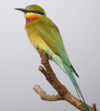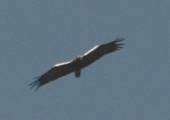 INTRODUCTION
INTRODUCTION
I spent a week in Madrid with my wife and booked two morning trips with guide Luis Sitges of Birding Trekking & Nature, taking in the Madrid region. The city and its surrounding region hold a fantastic variety of habitat and birds to match, even in August!
MONDAY 19th AUGUST - 07:00 to 14:00 Hot and sunny 39°C
07:00 An early start to offset the expected heat of the morning. It was already 23°C when we left the city.
Jarama Valley
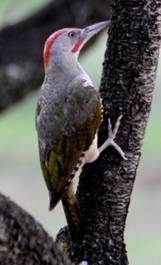 This is an area of cultivated plains north of Madrid, which is transversed by the Jarama River, thus greatly enhancing the bio-diversity of the area. Our first stop was some riverine forest and as we walked along the banks of the river we saw several species, including Cetti's Warbler, Black Kite, Stock Dove, Wood Pigeon, Golden Oriole, Great Spotted and Green Woodpecker, Goldfinch, Tree Sparrow, House Sparrow, Collared Dove, Common Buzzard, Hen Harrier, Nightingale and Corn Bunting. However the colony of Spanish Sparrows had dispersed and no birds were seen. We continued on northwards and entering an area of large harvested cereal fields, we spotted several Great Bustard and Little Bustard feeding in the morning light. The additional cast wasn't bad either with Marsh Harrier, Montagu's Harrier and Crested Lark all showing well. A second Short-toed Eagle was sitting on a tree near the road as well as a Southern Grey Shrike. Time was passing quickly so Luis decided to try the mountains before it got too hot.
This is an area of cultivated plains north of Madrid, which is transversed by the Jarama River, thus greatly enhancing the bio-diversity of the area. Our first stop was some riverine forest and as we walked along the banks of the river we saw several species, including Cetti's Warbler, Black Kite, Stock Dove, Wood Pigeon, Golden Oriole, Great Spotted and Green Woodpecker, Goldfinch, Tree Sparrow, House Sparrow, Collared Dove, Common Buzzard, Hen Harrier, Nightingale and Corn Bunting. However the colony of Spanish Sparrows had dispersed and no birds were seen. We continued on northwards and entering an area of large harvested cereal fields, we spotted several Great Bustard and Little Bustard feeding in the morning light. The additional cast wasn't bad either with Marsh Harrier, Montagu's Harrier and Crested Lark all showing well. A second Short-toed Eagle was sitting on a tree near the road as well as a Southern Grey Shrike. Time was passing quickly so Luis decided to try the mountains before it got too hot.
Patones
We stopped at a gorge which Luis knew was good for Blue Rock Thrush and just as we parked the car we saw the first of four birds in the car park area, a male Black Redstart was also seen. We stopped for ten minutes for something to eat and saw a Thekla Lark close by, we then moved on to Rascafria.
Rascafria
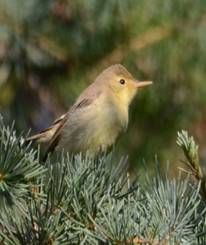 Rascafria is a wooded area with riverine vegetation; a Reed Warbler was an unusual find. Chaffinch, Coal Tit, Great Tit, Long-tailed Tit, Robin, Blue Tit, and Pied Wagtail were all found in and around the gardens of Monasterio del Santa Maria. Walking along the track we observed Pied Flycatcher iberiae, migrating Willow Warbler and Chiffchaff, European Bee-eater with Barn Swallow, House Martin, Crag Martin, Red-rumped Swallow and Common Swift overhead.
Rascafria is a wooded area with riverine vegetation; a Reed Warbler was an unusual find. Chaffinch, Coal Tit, Great Tit, Long-tailed Tit, Robin, Blue Tit, and Pied Wagtail were all found in and around the gardens of Monasterio del Santa Maria. Walking along the track we observed Pied Flycatcher iberiae, migrating Willow Warbler and Chiffchaff, European Bee-eater with Barn Swallow, House Martin, Crag Martin, Red-rumped Swallow and Common Swift overhead.
Puerto de La Morcuera [1796m]
Here we stopped and walked around near to the Refugio. Woodlark, Raven, Carrion Crow, Northern Wheatear, Mistle Thrush, Serin, Linnet, Coal Tit, Great Tit, Short-toed Treecreeper, Common Redstart, Red-rumped Swallow, Common Swift, Booted Eagle, Honey Buzzard, Crag Martin and Woodlark were all on show.
Santillana Reservoir
We stopped at the embalse for a quick look; additions to our list were Purple Heron, Common Coot, Moorhen, Black-headed Gull, Yellow-legged Gull, Red Kite, Gadwall, Black Kite, Cattle Egret, Little Egret, White Stork, Kingfisher, Common Buzzard and Gadwall. The temperature was beginning to rise, so we headed quickly to our last stop El Pardo.
El Pardo
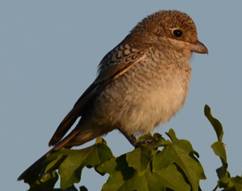 We had a stroke of luck when we arrived at this site; apparently something of interest was just over the hill to the left of the car park area and the vultures were streaming in from all sides. We got amazing views, practically overhead, of Black Vulture and Griffon Vulture, incredibly close to such huge birds. This is probably the best site in the Madrid area for Spanish Imperial Eagle and we weren’t disappointed, with at least two adults and one juvenile in view. Other birds seen were Woodchat Shrike, adults and young, another Short-toed Eagle, Cetti's Warbler, Grey Heron, Crested Lark, Long-tailed Tit, Serin, Spotless Starling, Monk Parakeet and hundreds of White Stork high in the sky: A brilliant end to the morning's birding. It was now 39°C and very hot; time to go back to the hotel.
We had a stroke of luck when we arrived at this site; apparently something of interest was just over the hill to the left of the car park area and the vultures were streaming in from all sides. We got amazing views, practically overhead, of Black Vulture and Griffon Vulture, incredibly close to such huge birds. This is probably the best site in the Madrid area for Spanish Imperial Eagle and we weren’t disappointed, with at least two adults and one juvenile in view. Other birds seen were Woodchat Shrike, adults and young, another Short-toed Eagle, Cetti's Warbler, Grey Heron, Crested Lark, Long-tailed Tit, Serin, Spotless Starling, Monk Parakeet and hundreds of White Stork high in the sky: A brilliant end to the morning's birding. It was now 39°C and very hot; time to go back to the hotel.
THURSDAY 22nd AUGUST - 07:00 to 12:30 Sunny 36°C
Luis wanted to try for Spanish Sparrow at a site to the south-east of the city, Parque Regional del Sureste, where he had seen the birds several times lately. So once again we had an early start and set off at 07:00 from the hotel.
Parque Regional del Sureste
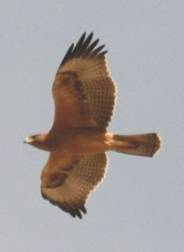 The Parque offers superb birding habitat bordered on one side by the conjunction of the Jarama and Manzanares rivers and on the other by limestone bluffs, interspersed with riverine and pine forests. As we walked towards the cliffs we crossed over a bridge and here we found both Common and Green Sandpiper. Continuing through farmland towards the cliffs Tree and House Sparrow were in abundance but Spanish Sparrow remained elusive and I dipped on this species. However we were to see an amazing sight of migrating Black Kite; 1000-2000 birds roosting in the riverine forest, before setting out along the bluffs to catch a thermal. In addition several hundred White Stork were taking to the air at the same time; a wonderful site in the morning sunlight. We walked for about 3 km along the track which skirts the river and it was pretty good as well. The highlight being brilliant views of a juvenile Bonelli's Eagle, which was a great find when you consider there are only a few pairs in the entire Madrid area. Other birds seen in the area were Golden Oriole, Blackbird, Redstart, Short-toed Eagle, Woodchat Shrike, Red Kite, Black Kite, White Wagtail, Mallard, Shoveler, Spotted Flycatcher, Pied Flycatcher, Booted Eagle, Hoopoe, Common Kestrel, Rock Dove, Sand Martin, Red-legged Partridge and Purple Heron. The walk ended with finding several Black Wheatear and Sardinian Warbler. Two targets missed were Turtle Dove, which is now rare in the region and Spanish Sparrow which isn't but you would have a much better chance in May when they are breeding.
The Parque offers superb birding habitat bordered on one side by the conjunction of the Jarama and Manzanares rivers and on the other by limestone bluffs, interspersed with riverine and pine forests. As we walked towards the cliffs we crossed over a bridge and here we found both Common and Green Sandpiper. Continuing through farmland towards the cliffs Tree and House Sparrow were in abundance but Spanish Sparrow remained elusive and I dipped on this species. However we were to see an amazing sight of migrating Black Kite; 1000-2000 birds roosting in the riverine forest, before setting out along the bluffs to catch a thermal. In addition several hundred White Stork were taking to the air at the same time; a wonderful site in the morning sunlight. We walked for about 3 km along the track which skirts the river and it was pretty good as well. The highlight being brilliant views of a juvenile Bonelli's Eagle, which was a great find when you consider there are only a few pairs in the entire Madrid area. Other birds seen in the area were Golden Oriole, Blackbird, Redstart, Short-toed Eagle, Woodchat Shrike, Red Kite, Black Kite, White Wagtail, Mallard, Shoveler, Spotted Flycatcher, Pied Flycatcher, Booted Eagle, Hoopoe, Common Kestrel, Rock Dove, Sand Martin, Red-legged Partridge and Purple Heron. The walk ended with finding several Black Wheatear and Sardinian Warbler. Two targets missed were Turtle Dove, which is now rare in the region and Spanish Sparrow which isn't but you would have a much better chance in May when they are breeding.
SUMMARY
Madrid certainly lived up to its reputation as possibly the best city in Europe to go birding in. I can only imagine what it would be like if you came in late April/early May. The only other species of note was a Melodious Warble seen in a city park beside my hotel, Quinta de los Molinas, a fabulous place for birds in the Autumn. In all we saw 90 species in two mornings in the Madrid region, in August, plus the Melodious Warbler; remarkable, when you consider we were in a heatwave, even by Spanish standards!!
My thanks to Luis for being a wonderful guide and good company. Luis can cater for 1-7 guests and I would have no hesitation in recommending him to other birders.
Trip List
Trip Report PDF version
Ed.O'Hara
Lurgan
N.Ireland
28.8.13
